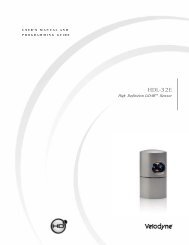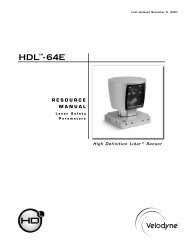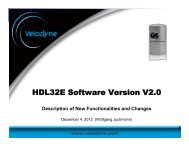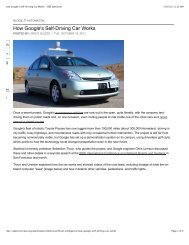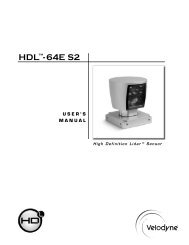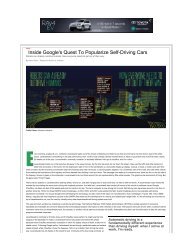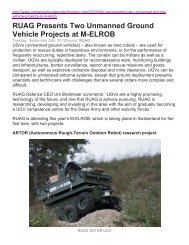On the Segmentation of 3D LIDAR Point Clouds - Velodyne Lidar
On the Segmentation of 3D LIDAR Point Clouds - Velodyne Lidar
On the Segmentation of 3D LIDAR Point Clouds - Velodyne Lidar
Create successful ePaper yourself
Turn your PDF publications into a flip-book with our unique Google optimized e-Paper software.
<strong>of</strong> parameters tested. The best results for dense and sparse<br />
data are provided in Tables I and II, respectively. The best<br />
results across methods are indicated in bold. The type <strong>of</strong><br />
implementation used is also indicated. The output <strong>of</strong> each<br />
technique is fur<strong>the</strong>r illustrated in <strong>the</strong> video associated with<br />
this submission (a longer version <strong>of</strong> this video is available at:<br />
http://www.acfr.usyd.edu.au/afmr/segmentation/icra11results.wmv).<br />
A. Dense Data Results<br />
Four hand labeled data sets (with point-wise labels) are<br />
used in this first set <strong>of</strong> experiments: two are formed from a<br />
single Riegl scan, one acquired at Drexel University, US,<br />
and a second one at <strong>the</strong> University <strong>of</strong> Sydney, Australia<br />
(Fig. 1); ano<strong>the</strong>r set is generated by combining vertical<br />
scans from a SICK laser with <strong>the</strong> navigation solution <strong>of</strong> <strong>the</strong><br />
mobile platform <strong>the</strong> sensor is mounted on; and a fourth set is<br />
obtained by combining <strong>Velodyne</strong> scans and navigation data.<br />
The four point clouds were acquired in static environments.<br />
1) Cluster-All <strong>Segmentation</strong> Method: For this experiment,<br />
<strong>the</strong> role <strong>of</strong> voxels size was tested. The two plots in Fig. 5 are<br />
<strong>the</strong> point and voxel scores versus voxel size in centimeters<br />
and neighbourhood. The neighbourhood value is <strong>the</strong> absolute<br />
magnitude <strong>of</strong> <strong>the</strong> distance two voxels can be away from each<br />
o<strong>the</strong>r, in terms <strong>of</strong> voxel grid spaces. For example two voxels<br />
that are touching but one grid <strong>of</strong>f in x or y would have a<br />
magnitude <strong>of</strong> 1, and if <strong>the</strong> voxels were only touching corner<br />
to corner that would be a magnitude <strong>of</strong> 3. The voxel size<br />
tests show a peak at 0.2m. In terms <strong>of</strong> computation times,<br />
at a voxel sizes <strong>of</strong> 0.1m, 0.2m, and 0.4m processing took<br />
on average 8.02s, 4.30s, and 3.82s respectively (<strong>the</strong>se times<br />
cannot be directly compared to <strong>the</strong> o<strong>the</strong>r tests because a<br />
different data structure was used to allow a larger number <strong>of</strong><br />
voxels to be represented). The peak match percentage occurs<br />
with a voxel size <strong>of</strong> 0.2m. Since a significant time penalty<br />
is incurred for smaller voxels and minimal time savings are<br />
achieved with larger voxels, <strong>the</strong> conclusion can be made that<br />
0.2m is optimal based on <strong>the</strong>se tests. The scores reported in<br />
Table I correspond to this parameter choice.<br />
Fig. 5. Cluster-All <strong>Segmentation</strong>, Scores <strong>of</strong> Variance Tests and Voxel Size<br />
Tests.<br />
A variant <strong>of</strong> Cluster-All involving a varying neighbourhood<br />
size was also tested. It is illustrated in Fig. 7(a). The<br />
density <strong>of</strong> objects and <strong>the</strong> density <strong>of</strong> scan points is greater at<br />
lower heights above ground due to objects naturally resting<br />
on <strong>the</strong> ground and <strong>the</strong> corresponding proximity <strong>of</strong> <strong>the</strong> sensor.<br />
Employing larger neighbourhoods a certain distance above<br />
<strong>the</strong> ground can prevent over-segmentation <strong>of</strong> high sparse<br />
objects while not risking under-segmentation <strong>of</strong> objects close<br />
toge<strong>the</strong>r on <strong>the</strong> ground. The corresponding results are reported<br />
in <strong>the</strong> line ‘Cluster-All with Variable Neighbourhood’<br />
Fig. 6. Base-Of <strong>Segmentation</strong>, Match Results vs Standard Deviation and<br />
<strong>3D</strong> Neighbourhood.<br />
<strong>of</strong> table I. In <strong>the</strong>se tests <strong>the</strong> neighbourhood was restricted to 3<br />
for voxels less than 2 meters above <strong>the</strong> ground and extended<br />
to 6 o<strong>the</strong>rwise.<br />
2) Base-Of <strong>Segmentation</strong> Method: For this method two<br />
parameters were varied and all tests were run both with<br />
and without <strong>the</strong> ExtractGround operation (Algorithm 1).<br />
Fig. 6 shows <strong>3D</strong> plots <strong>of</strong> <strong>the</strong> average results for <strong>the</strong> four<br />
dense data sets. While Base-Of without ground extraction<br />
has <strong>the</strong> advantage <strong>of</strong> being almost twice as fast as <strong>the</strong> ground<br />
based methods, it is behind <strong>the</strong> o<strong>the</strong>r techniques in terms <strong>of</strong><br />
accuracy. This result experimentally confirms <strong>the</strong> usefulness<br />
<strong>of</strong> explicit ground extraction in <strong>3D</strong> segmentation.<br />
B. Sparse Data Results<br />
Four hand labeled <strong>Velodyne</strong> scans (with point-wise labels)<br />
are used for <strong>the</strong> evaluation <strong>of</strong> <strong>the</strong> sparse methods. The results<br />
are presented in Table II and were obtained by averaging<br />
performance and computation times over <strong>the</strong> four labeled<br />
scans (<strong>the</strong> same as <strong>the</strong> dense data results).<br />
1) Cluster-All <strong>Segmentation</strong>: The following three parameters<br />
are varied to obtain <strong>the</strong> best point and voxel scores:<br />
maxvstd, <strong>the</strong> maximal vertical standard deviation in a voxel<br />
below which this voxel is identified as belonging to <strong>the</strong><br />
ground in <strong>the</strong> function ExtractGround; groundres, <strong>the</strong><br />
resolution <strong>of</strong> <strong>the</strong> grid used in ExtractGround; objectres,<br />
<strong>the</strong> resolution <strong>of</strong> <strong>the</strong> grid used in SegmentVoxelGrid.<br />
The results are shown in Fig. 7(b). In both cases, <strong>the</strong><br />
optimal parameter values are 0.3m for maxvstd, 0.5m for<br />
groundres and 0.2m for objectres, and correspond to <strong>the</strong><br />
best scores reported in Table II.<br />
2) GP-INSAC <strong>Segmentation</strong>: The complete GP-INSAC<br />
sparse segmentation method has a total <strong>of</strong> seven parameters,<br />
grouped by <strong>the</strong> stages in <strong>the</strong> pipeline. INSAC requires t data<br />
and t model , <strong>the</strong> cylindrical seed region requires R s and B s ,<br />
data compression uses r and d, and <strong>the</strong> final partitioning<br />
step is parameterised by <strong>the</strong> grid resolution. The GP model<br />
employs a squared exponential covariance with three parameters:<br />
length scale, process and data noise (ls, σ p , σ d ), which<br />
are learnt <strong>of</strong>f-line with a maximum likelihood approach [18],<br />
by manually providing segments <strong>of</strong> ground data. <strong>On</strong>ce learnt,<br />
<strong>the</strong>se parameters are fixed for <strong>the</strong> GP-INSAC algorithm.




